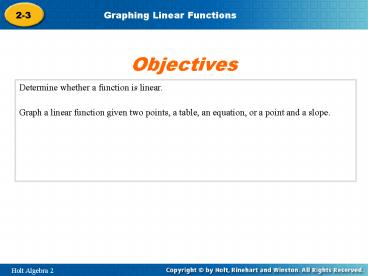Determine whether a function is linear. PowerPoint PPT Presentation
1 / 18
Title: Determine whether a function is linear.
1
Objectives
Determine whether a function is linear. Graph
a linear function given two points, a table, an
equation, or a point and a slope.
2
Meteorologists begin tracking a hurricane's
distance from land when it is 350 miles off the
coast of Florida and moving steadily inland. The
meteorologists are interested in the rate at
which the hurricane is approaching land.
Time (h) 0 1 2 3 4
Distance from Land (mi) 350 325 300 275 250
3
Functions with a constant rate of change are
called linear functions. A linear function can be
written in the form f(x) mx b, where x is the
independent variable and m and b are constants.
The graph of a linear function is a straight line
made up of all points that satisfy y f(x).
4
Determine whether the data set could represent a
linear function.
x 2 0 2 4
f(x) 2 1 0 1
5
Determine whether the data set could represent a
linear function.
x 2 3 4 5
f(x) 2 4 8 16
6
Determine whether the data sets could represent a
linear function.
x 4 11 18 25
f(x) 6 15 24 33
x 10 8 6 4
f(x) 7 5 1 7
7
(No Transcript)
8
Plot the point (1, 3).
The slope indicates a rise of 5 and a run of 2.
Move up 5 and right 2 to find another point.
Then draw a line through the points.
9
Graph the line with slope that passes
through (0, 2).
Plot the point (0, 2).
You can move down 3 units and right 4 units, or
move up 3 units and left 4 units.
10
Recall from geometry that two points determine a
line. Often the easiest points to find are the
points where a line crosses the axes. The
y-intercept is the y-coordinate of a point
where the line crosses the x-axis. The
x-intercept is the x-coordinate of a point where
the line crosses the y-axis.
11
Find the intercepts of 4x 2y 16, and graph
the line.
Find the x-intercept 4x 2y 16
4x 2(0) 16
Substitute 0 for y.
4x 16
x 4
The x-intercept is 4.
Find the y-intercept 4x 2y 16
4(0) 2y 16
Substitute 0 for x.
2y 16
y 8
The y-intercept is 8.
12
Find the intercepts of 6x 2y 24, and graph
the line.
Find the x-intercept 6x 2y 24
6x 2(0) 24
Substitute 0 for y.
6x 24
x 4
The x-intercept is 4.
Find the y-intercept 6x 2y 24
6(0) 2y 24
Substitute 0 for x.
2y 24
y 12
The y-intercept is 12.
13
Linear functions can also be expressed as linear
equations of the form y mx b. When a linear
function is written in the form y mx b, the
function is said to be in slope-intercept form
because m is the slope of the graph and b is the
y-intercept. Notice that slope-intercept form is
the equation solved for y.
14
Graph the function y 2x 9.
15
Write the function 4x y 1 in
slope-intercept form. Then graph the function.
Solve for y first.
4x y 1
Add 4x to both sides.
y 4x 1
16
An equation with only one variable can be
represented by either a vertical or a horizontal
line.
The slope of a vertical line is undefined. The
slope of a horizontal line is zero.
17
Vertical and Horizontal Lines Vertical and Horizontal Lines
Vertical Lines Horizontal Lines
The line x a is a vertical line at a. The line y b is a vertical line at b.
18
Determine if each line is vertical or horizontal.
A. x 2
This is a vertical line located at the x-value 2.
(Note that it is not a function.)
x 2
y 4
B. y 4
This is a horizontal line located at the y-value
4.

